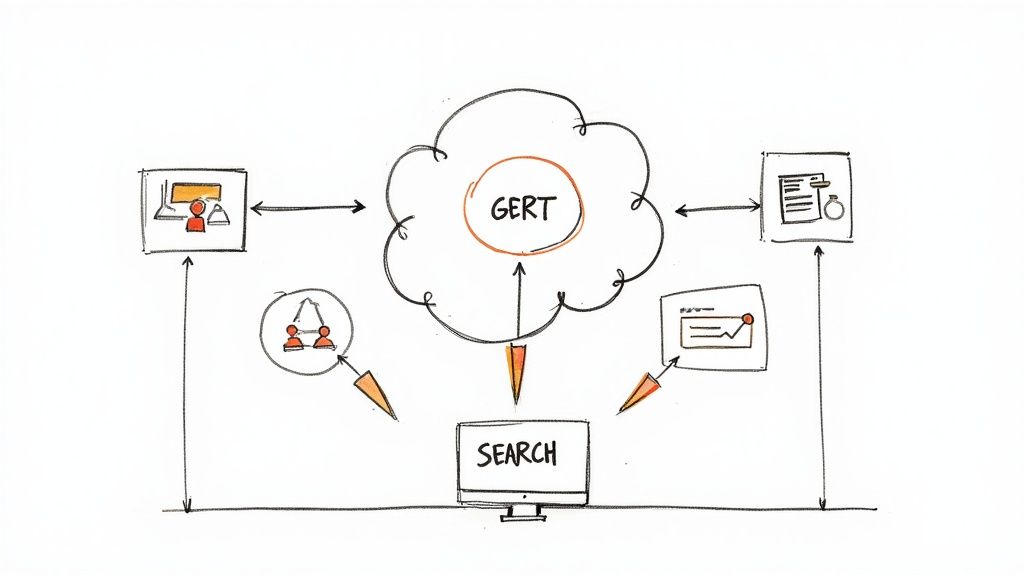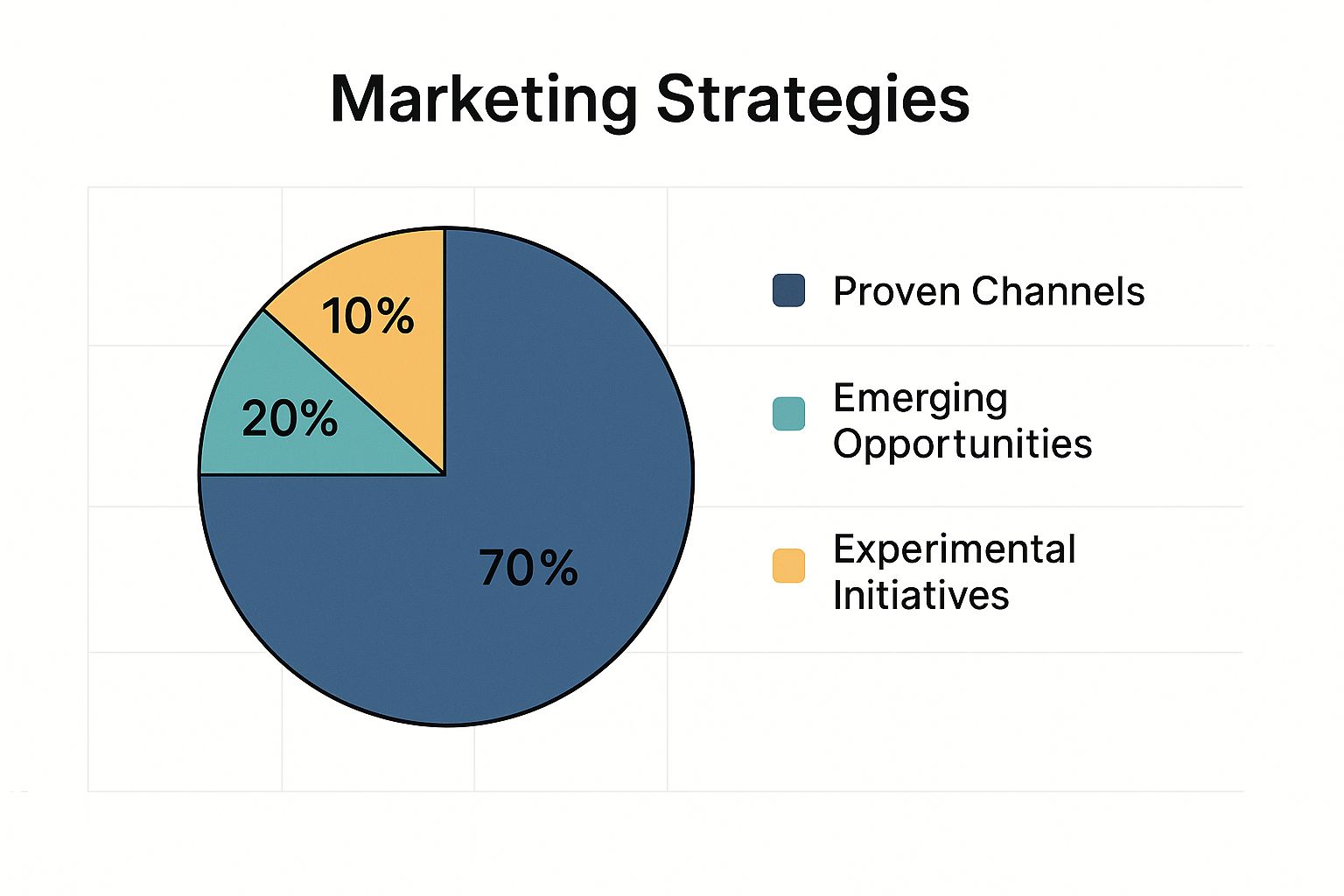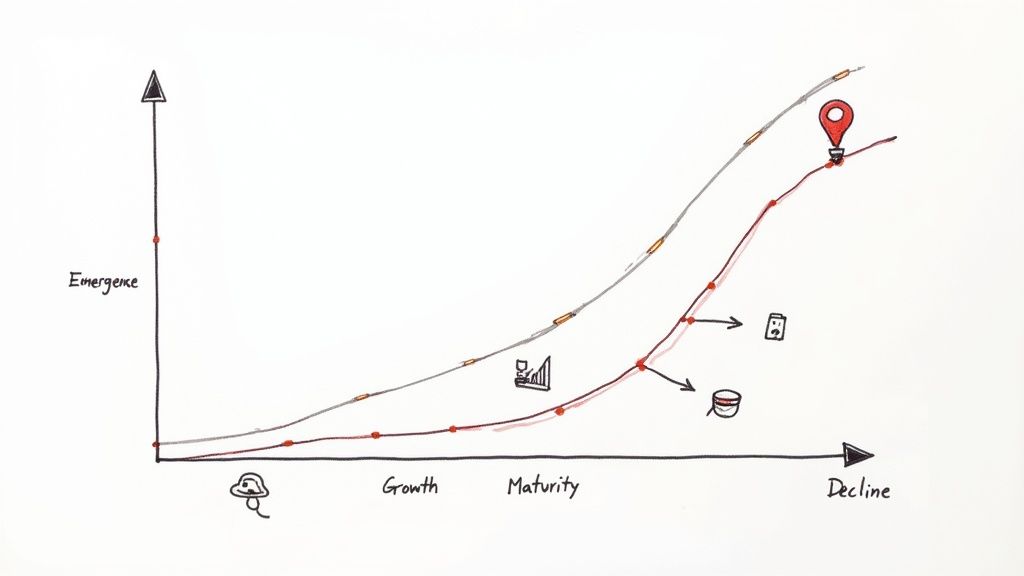7 Marketing Budget Allocation Best Practices for 2025
For a lean startup, every dollar is a bullet. A poorly aimed marketing budget isn't just a waste—it's a threat to survival. The gap between explosive growth and stagnation isn't how much you spend, but how you invest.
Forget "spend money to make money." This guide delivers proven, actionable marketing budget allocation best practices that swap guesswork for precision-guided growth. We're breaking down the frameworks industry leaders use, tailored for founders who need every dollar to work overtime. No vague tips here—only structured methods to max out your ROI.
This article shows you how to execute advanced strategies, including:
Data-Driven Attribution: Uncover your true conversion drivers, not just the last click.
The 70-20-10 Rule: Balance proven winners with game-changing experiments.
CLV-Based Allocation: Stop chasing every customer and start acquiring the best ones.
MROAS Optimization: Find the exact point where more ad spend stops paying off.
These seven practices will turn your budget from an expense line into a predictable growth engine. Let's dive in.
1. Data-Driven Attribution Modeling
Stop spending on assumptions. Start spending with data. Data-driven attribution modeling dissects the entire customer journey to reveal which channels and touchpoints actually drive conversions. It’s a massive upgrade from simplistic models like last-click, which wrongly credits the final interaction and ignores the crucial moves made earlier in the game.

By giving credit where it's due, you get a clear picture of what works. This clarity lets you allocate your limited budget with surgical precision, doubling down on channels with the highest impact on revenue, not just those that show up last in the conversion path.
Why It's a Game-Changer
This model means you stop guessing and start knowing. Spotify reportedly slashed its customer acquisition costs by 30% after implementing a sophisticated attribution model. Adobe used a similar tool to boost marketing ROI by 25%. The lesson: understanding the entire conversion story is the key to efficient spending.
To master how to credit touchpoints, this guide on Attribution Modeling provides the insights you need to build a robust measurement system.
How to Implement It
You don't need a huge analytics team to get started. Here’s how to make it happen:
Nail Your UTM Tracking: Make every link trackable. Use consistent UTM parameters across all channels (email, social, ads). This is your foundation.
Master First-Party Data: Use what you have. Dig into Google Analytics to analyze customer paths on your site before adding complex third-party data.
Test Multiple Models: Don't settle. Compare linear, time-decay, and data-driven models in your analytics platform to see what best fits your sales cycle.
Validate with Holdout Tests: Prove your model works. Pause a channel (like brand search ads) for a control group and measure the impact. This confirms the value your model assigns.
2. The 70-20-10 Rule
Here's a battle-tested framework for marketing budget allocation: the 70-20-10 rule. This model, pioneered by Google, creates a balanced portfolio. It dedicates 70% of your budget to your core, proven marketing activities, 20% to emerging channels, and 10% to high-risk, experimental bets.
This structure guarantees you maintain momentum with what works while actively exploring new growth avenues. For a startup, it's a disciplined way to balance short-term wins with long-term survival, stopping you from stagnating in old channels or recklessly chasing shiny objects.
This pie chart breaks down the budget, offering a clear framework for balancing risk and stability.

As you can see, the bulk of your resources fuels reliable channels, but you still reserve a powerful slice for innovation and calculated risks.
Why It's a Game-Changer
The 70-20-10 rule forces structured innovation. Coca-Cola used it to dominate, allocating 70% to traditional ads, 20% to digital, and 10% to experimental platforms. HubSpot applies it to content, funding its reliable blog (70%) while investing in video (20%) and new formats (10%).
For you, this means confidently funding your core channels like SEO (the 70%), while methodically testing platforms like TikTok (the 20%), and placing small bets on new AI-driven ad platforms (the 10%).
How to Implement It
Adopting this rule requires clear categories and regular reviews. Get started with these steps:
Define Your Buckets: Classify your marketing. "70%" is for channels with predictable ROI. "20%" is for promising but less consistent channels. "10%" is for pure experiments with no immediate ROI expectation.
Set Different Goals: Each bucket needs its own KPIs. Measure the 70% on efficiency (ROI, CPA). The 20% on growth signals (engagement, early conversions). The 10% on pure learning.
Keep a "Learning Log": Document your 10% experiments. Hypothesis? Test? Results? This log is the real ROI of your experimental spend.
Review and Rebalance Quarterly: Your budget isn't static. A successful 20% initiative might graduate to the 70% bucket. A failed 10% experiment gets cut. This keeps your allocation sharp.
3. Customer Lifetime Value (CLV) Based Allocation
A truly strategic marketing budget looks beyond the first sale. CLV-based allocation focuses spending on channels that attract high-value customers. It's about long-term profitability, not just short-term cost per acquisition (CPA). This means you might deliberately spend more to acquire certain customers, knowing their lifetime revenue justifies the upfront cost.

This method shifts your focus from acquiring any customer to acquiring the right one. By knowing which segments spend more, stick around longer, and become advocates, you can aim your budget at marketing that cultivates these relationships and drives sustainable growth.
Why It's a Game-Changer
Focusing on CLV turns marketing from a cost center into a growth engine. Amazon famously spends more to acquire Prime members because their CLV is massive. SaaS companies like Netflix invest heavily to acquire demographics with high retention rates. This foresight prevents you from wasting money on high-churn customers. The first step is mastering calculating Customer Lifetime Value (CLV), which this guide details.
To dive deeper, learn how to calculate customer lifetime value and bake it into your strategy.
How to Implement It
You don't need a data science PhD to start leveraging CLV. Get moving with these steps:
Build a Simple CLV Model: Start with historical data. Calculate average purchase value, frequency, and customer lifespan for different segments. This creates your baseline CLV.
Segment by Behavior: Go beyond demographics. Group customers by first product purchased, engagement level, or acquisition channel to see which starting points create the most value.
Use Predictive Tools: Use your CRM's features to find prospects who look like your current high-CLV customers. Target them with tailored campaigns.
Combine CLV and Attribution: Don't use CLV in a vacuum. Overlay it with your attribution model to find channels that not only convert but bring in the most profitable customers.
4. Marginal Return on Ad Spend (MROAS) Optimization
Ready for a pro move? Shift your focus from average ROAS to marginal return on ad spend (MROAS). MROAS measures the revenue generated by the very next dollar you spend. This acknowledges a hard truth: every channel eventually hits a point of diminishing returns, where adding more budget delivers less and less impact.
By optimizing for MROAS, you allocate funds until the marginal return of each channel is equal. This maximizes efficiency by ensuring every dollar is spent where it generates the highest possible immediate return, stopping you from over-investing in saturated channels.
Why It's a Game-Changer
Moving from average ROAS to MROAS is like swapping a sledgehammer for a scalpel. Instead of just pouring money into a channel with a good "average" performance, you find the exact spending cap where it stops being efficient. Procter & Gamble boosted its marketing efficiency by 20% using MROAS. Booking.com uses it to manage its multi-billion dollar ad budget, justifying every incremental investment.
Mastering MROAS is key to modern performance marketing. This guide on how to measure marketing ROI provides a framework for quantifying your returns.
How to Implement It
MROAS sounds complex, but any startup can apply the principles. Here's how to start:
Set Channel Baselines: You can't measure marginal return without a baseline. Run each channel at a consistent budget to understand its typical performance.
Test Small Budget Bumps: Increase spend on one channel by a small amount (e.g., 10-15%), keeping everything else constant. Measure the extra revenue that specific increase generated. That's your MROAS.
Find the Saturation Point: Keep running these incremental tests until the return for each extra dollar starts to drop. That's your saturation point. Time to move funds elsewhere.
Use Automated Bidding: Platforms like Google and Facebook use MROAS principles in their algorithms. Use tools like Target ROAS or Target CPA bidding to automate this at a micro-level.
5. Channel Maturity and Lifecycle-Based Budgeting
Treat your channels like a stock portfolio. Each has a different risk profile and growth stage. Channel lifecycle-based budgeting allocates funds based on where each platform sits on its adoption curve. This means emerging channels get investment for growth, while mature channels are optimized for efficiency.
This method stops you from over-investing in saturated, expensive channels or missing the next big thing. By analyzing a channel’s lifecycle—from innovation to maturity and decline—you align your spending with its real ROI potential. It’s about being proactive, not reactive.
Why It's a Game-Changer
This model lets you capture huge returns by being an early mover. Dollar Shave Club blew up by investing heavily in YouTube when it was still an emerging channel. Glossier built its empire on Instagram while legacy brands were still stuck in print. They identified and dominated new channels before they became crowded and expensive.
This is how startups outmaneuver bigger rivals. It’s a framework for sustainable growth that balances high-risk, high-reward bets with stable returns from your proven workhorses.
How to Implement It
You can integrate this approach with a few focused steps. Here's how to start:
Map Your Channel Lifecycle: Plot your current channels on an adoption curve: Innovation, Early Adoption, Early Majority, Late Majority, Laggards. This map shows you where to invest, optimize, or divest.
Create an "Innovation Budget": Set aside a small, fixed percentage (e.g., 5-10%) of your total budget just for experimenting with new platforms. This protects your core budget while fueling innovation.
Set Graduation Rules: Define clear metrics for when an experimental channel "graduates" to a larger budget. This could be hitting a target CPA, engagement rate, or lead volume.
Hunt for Emerging Trends: Actively track new platforms and user behavior. Follow industry leaders and subscribe to tech trend reports to spot promising new channels early.
6. Incrementality Testing and Holdout Groups
Attribution tells you what happened along the customer journey. Incrementality testing answers a more critical question: did your marketing actually cause new business, or just take credit for sales that would have happened anyway? This rigorous approach uses controlled experiments and holdout groups to measure the true, incremental lift from your campaigns. It moves beyond correlation to prove causation.

By isolating a "holdout" group that doesn't see your ad, you can compare their behavior to the group that did. The difference in conversions is the real lift your marketing generated. This practice ensures your budget decisions are rooted in causal proof, not just observation.
Why It's a Game-Changer
Incrementality testing stops you from wasting money on channels that don’t actually drive new growth. eBay famously paused its brand search ads and saw almost no drop in sales, revealing the ads had little incremental impact. P&G used geographic holdouts to discover some digital ads weren’t driving new sales, leading to a massive budget reallocation. For startups, these insights are gold.
This is the ultimate validation for your marketing spend. Platforms like Meta even provide resources on measuring incremental lift, showing the industry's shift toward proving real impact.
How to Implement It
You don’t need a data science team to run basic holdout tests. Here’s how to start:
Test One Channel at a Time: Start simple. Create a holdout group for your next Facebook campaign or a specific email blast before trying complex, multi-channel tests.
Create Representative Groups: Your holdout and test groups must be statistically similar. Randomly assign users to each to avoid bias and get valid results.
Run It Long Enough: Don't pull the plug too early. Run the test long enough to cover your typical sales cycle and any lag effects in customer behavior.
Document Everything: Write down your methodology, duration, groups, and results. This makes it easier to get buy-in and repeat successful experiments.
7. Competitive Spend Analysis and Share of Voice Optimization
Stop staring at your own navel. Effective marketing budget allocation means analyzing the competitive landscape. This strategy uses competitive intelligence to decide how much to spend and where, ensuring your budget is enough to cut through the noise and steal market share. It’s not about outspending everyone; it’s about outsmarting them.
By monitoring competitor ad spend, channel mix, and messaging, you can spot gaps and opportunities. This prevents your marketing from being drowned out and helps you allocate resources to channels where you can achieve a dominant Share of Voice (SOV) with your target audience.
Why It's a Game-Changer
Operating in a vacuum is a recipe for failure. Competitive analysis keeps you grounded in market reality. Pepsi and Coca-Cola have done this for decades, constantly reacting to each other's ad spend. Samsung strategically ramps up its mobile ad budget during iPhone launches to challenge Apple's SOV when it matters most.
This tactic lets lean startups punch above their weight by finding less saturated channels or running more creative campaigns. A solid guide on competitor analysis for marketing can turn these insights into a powerful budgetary weapon.
How to Implement It
You don't need a massive intelligence budget to get started. Use these steps to integrate competitive analysis into your planning:
Use Competitive Intelligence Tools: Platforms like SEMrush, Ahrefs, or Similarweb can estimate competitor spending on paid search and display. They show you their keywords and ad copy, giving you a window into their playbook.
Dominate Key Segments: Don't try to win everywhere. Identify your most profitable customer segment and focus your budget on achieving high SOV on the channels they live on.
Plan Offensive and Defensive Plays: Create budget models for different scenarios. What’s your "offensive" budget to grab market share? What’s your "defensive" budget to protect your turf when a new rival appears?
Analyze Quality, Not Just Quantity: Look beyond spending figures. Assess the creativity and resonance of your competitors' campaigns. A smaller budget with a better message always wins.
7 Best Practices in Marketing Budget Allocation Comparison
Methodology | Implementation Complexity 🔄 | Resource Requirements ⚡ | Expected Outcomes 📊 | Ideal Use Cases 💡 | Key Advantages ⭐ |
|---|---|---|---|---|---|
Data-Driven Attribution Modeling | High: Requires data integration, ML | High: Advanced analytics tools needed | Accurate ROI attribution, real-time budget optimization | Multi-channel budgets, digital marketing optimization | Eliminates guesswork, continuous performance optimization |
The 70-20-10 Rule | Low: Simple percentage-based model | Low: Minimal tools required | Balanced risk-taking with innovation and stability | Businesses needing straightforward budget frameworks | Easy to follow, balances risk and reward |
Customer Lifetime Value (CLV) Allocation | Medium-High: Requires predictive analytics | Medium-High: Customer data & modeling | Long-term profitability, improved customer retention | Businesses focused on customer retention & value | Maximizes long-term ROI, sophisticated segmentation |
Marginal Return on Ad Spend (MROAS) Optimization | High: Complex economic modeling | High: Requires real-time analytics and automation | Maximized marketing efficiency, avoids diminishing returns | Large-scale, multi-channel marketing portfolios | Optimizes marginal gains, prevents overspending |
Channel Maturity & Lifecycle-Based Budgeting | Medium: Needs market/channel analysis | Medium: Requires ongoing channel management | Balanced growth and optimization based on channel stage | Marketing mixes with emerging & mature channels | Early adoption advantage, long-term strategic planning |
Incrementality Testing & Holdout Groups | High: Rigorous experimental design | High: Data scale & analytics expertise | Definitive proof of incremental impact, reduces waste | Validating marketing effectiveness, budget reallocation | Establishes causation, confidence in budget decisions |
Competitive Spend & Share of Voice Optimization | Medium-High: Competitive analysis | Medium-High: Intelligence tools & data | Competitive positioning, optimizes share of market | Markets with intense competition and dynamic spend | Aligns spend with market competition, identifies gaps |
From Budgeting to Growth Hacking: Your Next Move
Mastering your marketing budget isn't a one-time task; it's a dynamic discipline. These frameworks—from data-driven attribution to the 70-20-10 rule—are designed to turn your budget from a static document into a responsive growth engine. For a lean startup, this shift is a survival mechanism.
By embracing these marketing budget allocation best practices, you stop just spending money and start making strategic investments. You stop guessing which channels work and start proving it with incrementality tests. You level up from surface-level metrics to deep insights like CLV and MROAS, ensuring every dollar is maximized for profitable growth.
Turning Theory into Action
Here's the bottom line: perfect is the enemy of progress. Don't try to implement all seven strategies at once. Start small, stay agile, and build momentum. Here are your next moves:
Pick Your Starting Point: Choose one or two practices that solve your biggest problem now. Struggling to justify ad spend? Dive into MROAS. Channel mix feeling stale? Apply the 70-20-10 rule.
Establish Your Baseline: Document your current performance before you change anything. Know your CAC and ROAS. You can't measure improvement without a starting line.
Execute and Measure: Implement the strategy on a small scale. Run a holdout test for one campaign. Reallocate 10% of your budget to an experiment. Track the results for a fixed period, like one quarter.
Iterate and Expand: Analyze the data. Did it work? Use the insights to refine your approach and gradually roll out these principles across your entire budget.
Ultimately, mastering your marketing budget is about building a culture of accountability. It’s what separates startups that burn cash from those that build scalable businesses. Treat your budget as a strategic weapon, not a constraint, and you'll empower marketing to become a true driver of revenue. Your journey from budgeting to growth hacking starts now.
Ready to put these strategies into action faster? The Viral Marketing Lab provides a suite of ready-to-use templates, analytics dashboards, and growth hacking playbooks specifically designed for lean startups. Stop building from scratch and start executing with proven resources by visiting Viral Marketing Lab today.










